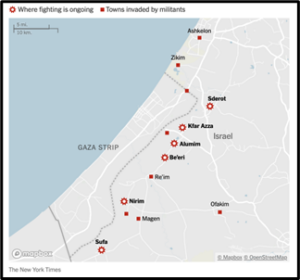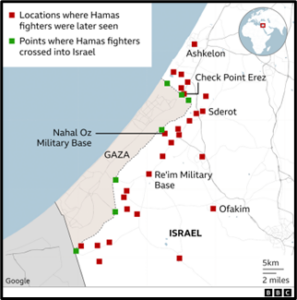Israel’s Operation Swords of Iron Update 10/9
Authors
Ari Cicurel – Assistant Director of Foreign Policy
Yoni Tobin – Policy Analyst
Zachary Schildcrout – Policy Analyst
On October 7, Hamas launched an unprovoked and unprecedented multi-prong attack on Israel by land, air, and sea. JINSA issued a NatSec Brief with an early assessment of the war on October 8. Below is updated information and analysis, which JINSA will continue to produce throughout the conflict.
Last 24 Hours
Attacks Against Israel
- Rocket fire on Monday injured Israelis in the southern cities of Ashdod and Ashkelon and impacted near Ben Gurion Airport. Alarms sounded today throughout southern Israel and in cities south of Tel Aviv, in the central cities of Holon and Rishon Lezion, and in northern Israel at Mevo’ot Hahermon Regional Council and the towns of Yiftah and Ramot Naftali.
- 12 rockets were reportedly fired from Lebanon into Israel.
- The IDF said that several individuals from Lebanon infiltrated Israeli territory.
- Residents of the northern Israeli village of Netua, near the Lebanese border, were ordered to lock their doors and stay indoors after reports of a possible security breach from Lebanon. There is also a shelter-in-place order for the northern city of Kiryat Shmona.
IDF Operations
- The IDF has mobilized three hundred thousand reservists, and Defense Minister Yoav Gallant announced a total blockade of the Gaza Strip.
- As of early Monday morning, the IDF had conducted 1,149 airstrikes against targets in the Gaza Strip, a significant increase from the reported approximate 800 airstrikes the IDF had launched as of mid-day Sunday.
- The IDF announced Monday morning that seven Hamas command centers were struck and that a total of over 500 combined Hamas and PIJ targets were struck.
- Israeli combat helicopters also struck targets inside of Lebanon after rocket fire from Lebanese soil.
- The IDF announced that it has retaken control of all Israeli border towns near Gaza but that there is still ongoing fighting on the ground. The IDF also announced that it had successfully repaired holes in the border fence, which is now secured by both tanks and fighter aircraft in addition to the physical barrier.
- Two Israeli hostages were rescued and four terrorists killed at a home in Ofakim on Saturday night.
Casualties and Hostages
- As of early Monday morning, the Israeli Health Ministry reported over 800 Israeli fatalities and at least 2,506 injured, including twenty-three in critical condition and 353 who are seriously hurt.
- At least nine Americans have been killed over the weekend, and the administration stated that it was still investigating reports that Americans had been taken hostage by Hamas.
- CNN is reporting that American, Brazilian, Mexican, and Thai nationals are still being held inside of Gaza by Hamas. These include two confirmed Mexican nationals and three confirmed Brazilian nationals. France announced seven of its citizens are missing after the attack.
- Palestinian officials said on Monday that 560 Gazans had been killed and 2,900 had been injured.
- An Israeli official rebuffed claims that Qatar-led hostage negotiations with Hamas were ongoing.
Iranian Involvement
- According to a Wall Street Journal report, Iran was involved in operational planning and authorized the attack last Monday, a claim Iranian officials have denied. The report claimed that IRGC members worked with Hamas since August to plan the attack and involved meetings in Beirut between Hamas, Hezbollah, the IRGC, and two other unspecified Iran-backed terrorist groups.
- A spokesperson for Hezbollah warned, “if the US intervenes directly, all US positions in the region will become legitimate targets of the resistance axis and face our attacks. And on that day there will be no red line.”
U.S. Response
- The Pentagon is deploying to the Eastern Mediterranean the USS Gerald R. Ford aircraft carrier and cruiser USS Normandy and destroyers USS Thomas Hudner, USS Ramage, USS Carney, and USS Roosevelt, and is sending additional Air Force F-35, F-15, F-16, and A-10 fighter aircraft squadrons to the region “to bolster regional deterrence efforts.”
- President Joe Biden spoke on the phone with Israeli Prime Minister Benjamin Netanyahu and offered, according to a readout of the conversation, “his full support for the Government and people of Israel in the face of an unprecedented and appalling assault by Hamas terrorists…[and] that additional assistance for the Israeli Defense Forces is now on its way to Israel with more to follow over the coming days. The leaders also discussed ongoing efforts to ensure that no enemies of Israel believe they can or should seek advantage from the current situation.”
- Secretary of Defense Lloyd Austin spoke with Israeli Defense Minister Yoav Gallant to “express support for the people of Israel” and, in addition to the deployment of assets to the Eastern Mediterranean, indicated that “the United States government will be rapidly providing the Israel Defense Forces with additional equipment and resources, including munitions.”
Analysis
- Additional rocket fire from Lebanon further raises the likelihood of the war escalating into a multi-front conflict. Whether the rocket fire on Monday was by Hezbollah or a different Iran-backed group, Hezbollah’s willingness to conduct or allow attacks from Lebanese soil is alarming, given its significantly larger and more capable weaponry compared to terrorists in Gaza.
- U.S. and Israeli officials have not indicated there is evidence yet to claim that Iran was directly involved, but the coordination and complexity of the multi-pronged attacks appear to indicate Iranian involvement.
- The U.S. deployment to the Eastern Mediterranean is clearly intended to be a deterrent signal to Iran and Hezbollah against expanding the conflict.


Click here to read Israel’s Operation Swords of Iron Update.